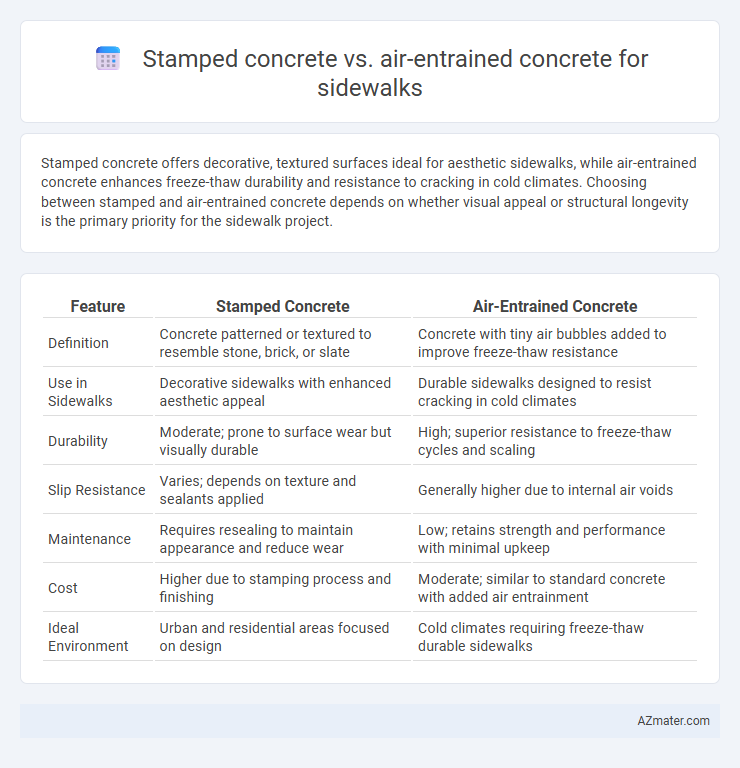Stamped concrete offers decorative, textured surfaces ideal for aesthetic sidewalks, while air-entrained concrete enhances freeze-thaw durability and resistance to cracking in cold climates. Choosing between stamped and air-entrained concrete depends on whether visual appeal or structural longevity is the primary priority for the sidewalk project.
Table of Comparison
| Feature | Stamped Concrete | Air-Entrained Concrete |
|---|---|---|
| Definition | Concrete patterned or textured to resemble stone, brick, or slate | Concrete with tiny air bubbles added to improve freeze-thaw resistance |
| Use in Sidewalks | Decorative sidewalks with enhanced aesthetic appeal | Durable sidewalks designed to resist cracking in cold climates |
| Durability | Moderate; prone to surface wear but visually durable | High; superior resistance to freeze-thaw cycles and scaling |
| Slip Resistance | Varies; depends on texture and sealants applied | Generally higher due to internal air voids |
| Maintenance | Requires resealing to maintain appearance and reduce wear | Low; retains strength and performance with minimal upkeep |
| Cost | Higher due to stamping process and finishing | Moderate; similar to standard concrete with added air entrainment |
| Ideal Environment | Urban and residential areas focused on design | Cold climates requiring freeze-thaw durable sidewalks |
Introduction to Stamped Concrete and Air-Entrained Concrete
Stamped concrete is a decorative concrete technique that mimics the appearance of natural materials like stone, brick, or wood, providing aesthetic appeal and durability for sidewalks. Air-entrained concrete incorporates microscopic air bubbles to enhance resistance to freeze-thaw cycles, improving longevity and preventing surface deterioration in outdoor pavements. Both materials serve different functional and visual purposes, with stamped concrete prioritizing design and air-entrained concrete focusing on structural integrity under harsh weather conditions.
Key Material Composition Differences
Stamped concrete incorporates integral color and hardening agents with release agents to create textured, decorative surfaces resembling stone or brick, emphasizing aesthetic appeal and surface durability. Air-entrained concrete contains microscopic air bubbles introduced by air-entraining agents to improve freeze-thaw resistance and reduce cracking, prioritizing durability in harsh weather conditions. These compositional differences directly influence the performance and longevity of sidewalks in various environmental contexts.
Performance Under Freeze-Thaw Cycles
Stamped concrete offers decorative appeal but may be more susceptible to surface damage during freeze-thaw cycles without proper sealing and air entrainment. Air-entrained concrete contains microscopic air bubbles that enhance its resistance to cracking and scaling caused by repeated freezing and thawing, making it ideal for sidewalks in cold climates. The presence of air entrainment significantly improves durability and extends the service life of sidewalks exposed to harsh freeze-thaw conditions.
Slip Resistance and Surface Texture Comparison
Stamped concrete offers enhanced slip resistance through its textured surface patterns mimicking natural materials, making it suitable for sidewalks requiring aesthetic appeal and safety. Air-entrained concrete, characterized by microscopic air bubbles, improves freeze-thaw durability and provides a naturally rougher texture that enhances slip resistance under wet conditions. Both types contribute to pedestrian safety, with stamped concrete emphasizing decorative slip resistance and air-entrained concrete focusing on functional texture for longevity and traction.
Durability and Longevity in Sidewalk Applications
Stamped concrete offers enhanced durability through its dense surface and customizable textures that resist cracking and wear in sidewalk applications. Air-entrained concrete significantly improves longevity by incorporating microscopic air bubbles that enhance freeze-thaw resistance, preventing surface scaling and deterioration in cold climates. Both materials contribute to long-lasting sidewalks, with stamped concrete excelling in abrasion resistance and air-entrained concrete providing superior durability against environmental stressors.
Aesthetic Options and Design Flexibility
Stamped concrete offers extensive aesthetic options with customizable patterns, colors, and textures that mimic natural stone, brick, or wood, allowing for highly detailed and decorative sidewalk designs. Air-entrained concrete primarily focuses on enhancing durability and freeze-thaw resistance, providing limited aesthetic variation but ensuring long-lasting structural integrity. For sidewalk applications where visual appeal and unique design flexibility are priorities, stamped concrete is the preferred choice due to its versatile decorative capabilities.
Installation Process and Required Expertise
Stamped concrete requires skilled artisans to expertly imprint patterns and textures onto fresh concrete, demanding precise timing and specialized tools during installation for achieving aesthetic appeal. Air-entrained concrete installation follows standard procedures similar to conventional concrete but includes air-entrainment agents to improve freeze-thaw durability, requiring knowledge of proper mixing proportions and curing practices. Expertise in surface finishing for stamped concrete contrasts with the technical understanding of admixture effects and environmental considerations essential for air-entrained concrete in sidewalk applications.
Maintenance Requirements and Costs
Stamped concrete sidewalks require regular sealing every 2-3 years to prevent cracking and color fading, with maintenance costs averaging $200-$300 per application. Air-entrained concrete enhances durability against freeze-thaw cycles, reducing the need for frequent repairs and lowering long-term maintenance expenses. Initial installation for stamped concrete is typically higher by 15-25%, but air-entrained concrete offers cost savings through extended lifespan and fewer surface treatments.
Environmental Impact and Sustainability
Stamped concrete often requires more energy-intensive production processes and decorative additives that can increase its environmental footprint compared to standard concrete types. Air-entrained concrete improves durability and freeze-thaw resistance, reducing maintenance needs and extending sidewalk lifespan, which contributes to sustainability by lowering resource consumption over time. Selecting air-entrained concrete for sidewalks supports eco-friendly construction by enhancing structural resilience while minimizing environmental impact through improved material efficiency.
Cost Analysis: Stamped vs Air-Entrained Concrete Sidewalks
Stamped concrete sidewalks typically incur higher initial costs due to the intricate patterns and coloring processes involved, with prices ranging from $8 to $18 per square foot, compared to air-entrained concrete's average cost of $5 to $10 per square foot. Air-entrained concrete offers enhanced durability and freeze-thaw resistance by introducing tiny air bubbles, potentially reducing long-term maintenance expenses despite its slightly higher hourly labor expenses. Evaluating total cost-effectiveness, stamped concrete adds aesthetic value that may increase property appeal, while air-entrained concrete optimizes lifespan and maintenance efficiency in colder climates.

Infographic: Stamped concrete vs Air-entrained concrete for Sidewalk
 azmater.com
azmater.com